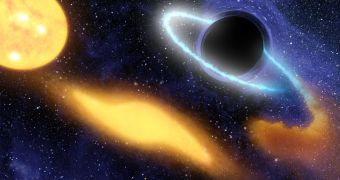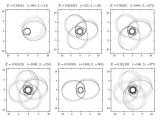So, is it possible to orbit around black holes without falling towards the singularity? Well, against general belief such maneuvers are actually possible. Objects coming in the vicinity of a black hole may enter elliptical orbits, resembling those of the planets in the solar system orbiting the Sun. However, the extreme gravitational fields produced by black holes also generate severe warps of the fabric of space-time meaning that orbits are much weirder than those around less massive objects, in concordance with Einstein's Theory of General Relativity.
As an object approaches a black hole in an orbit trajectory, it will describe a highly elongated path before drawing close to the black hole's event horizon, loop tightly around it, and fall into space in a similar elongated path before coming in for another fly-by. But while objects orbiting around less massive objects may occasionally follow identical paths in the same way, objects orbiting black holes may never experience identical trajectories, at least not in real life.
Columbia University physicists Janna Levin and Gabe Perez-Giz discovered, however, that, in theory, an object may experience a number of possible orbits around a black hole, which may repeat themselves exactly. This is done just by controlling the approach trajectory and speed, technique that may eventually lead to better models for detecting gravitational wave and space ripples determined by violent events during massive objects gravitational interactions, such as the merging of two black holes, for example.
A clear example of such identical orbits is a pattern resembling a cloverleaf, when an object describes a cloverleaf pattern which will repeat itself over and over again after reaching the original staring point. The team argues that every non-repeating path described by real life objects basically have corresponding trajectories that repeat themselves around the orbited object. The orbit of the Earth around the Sun, for example, could be described with the help of 10 million overlapping orbital trajectories, resembling a flower-like structure.
Further still, by organizing all the possible paths into different groups with repetitive paths, the team was able to sort the orbits into a table, which could be used to calculate the motion of bodies such as black holes, to reveal the existence of gravitational waves, as the pattern of gravitational waves is in direct relation to the motion on their orbits just before merging.
In fact, this is the whole deal of the story. The LIGO instrument looking for gravitational waves has collected an enormous amount of data, but filtering the data to reveal a single gravitational wave is like looking for a needle in a stack of needles. Black holes involved in studies may require as much as 10 parameters that describe them, so that a gravitational wave pattern may be calculated, amongst which mass, spin, spin direction, charge and others, some of which impossible to observe.

 14 DAY TRIAL //
14 DAY TRIAL // 
